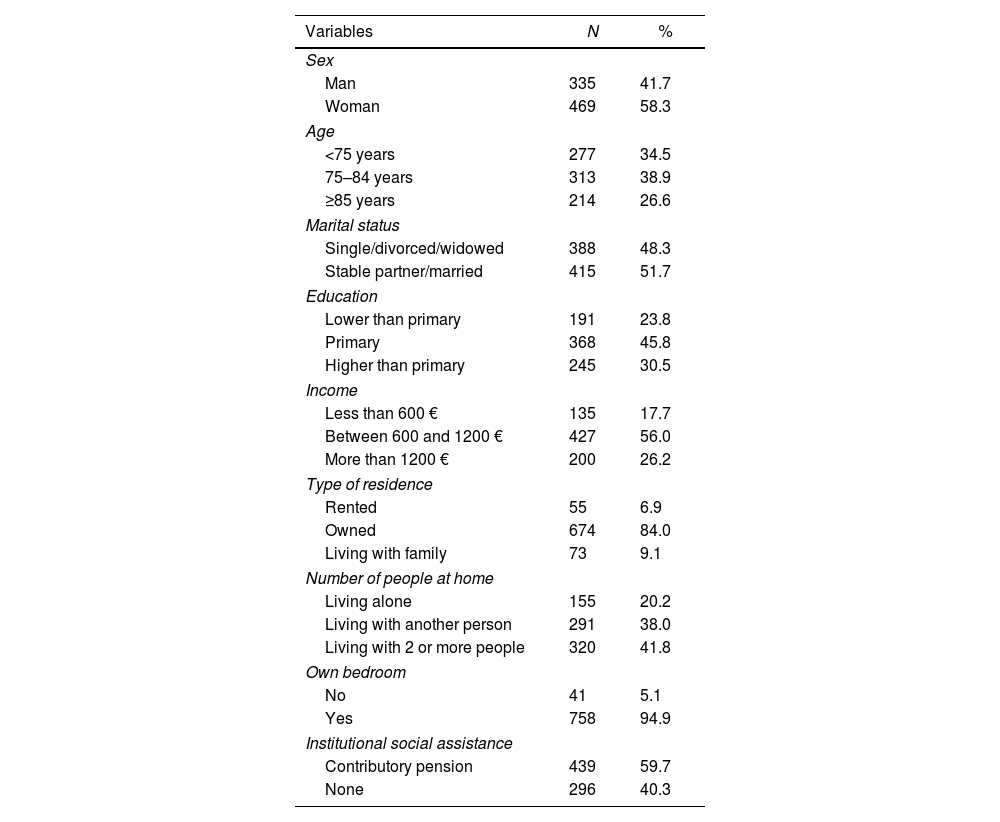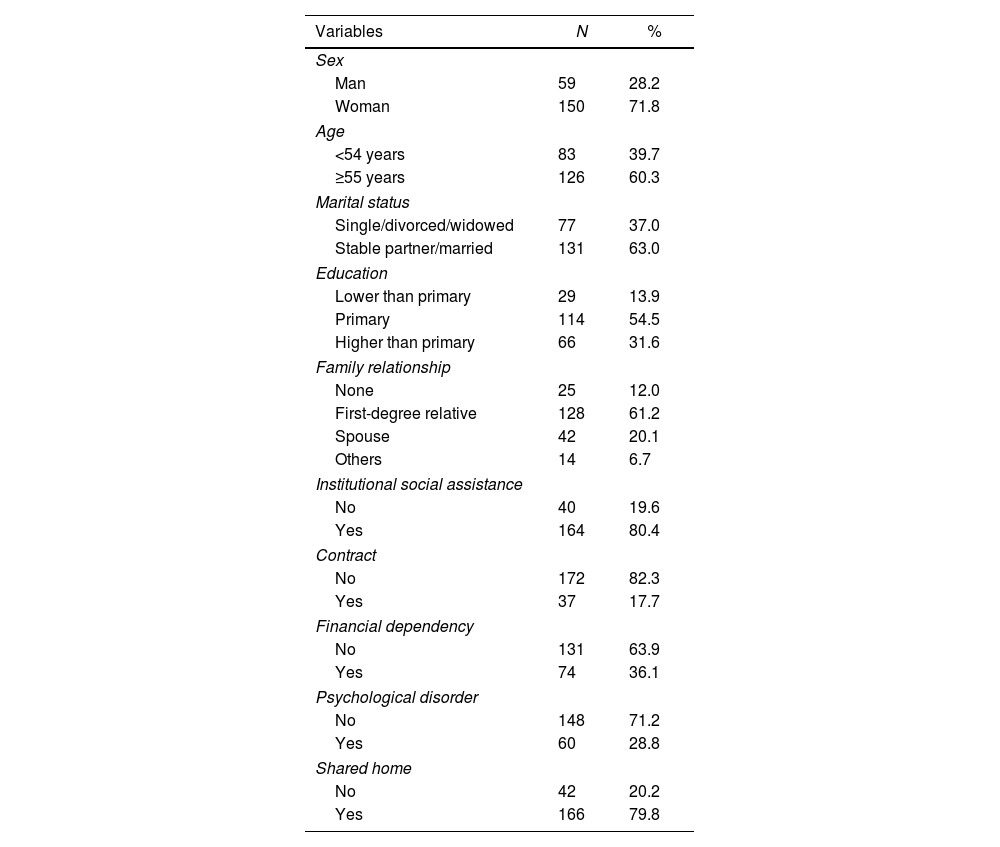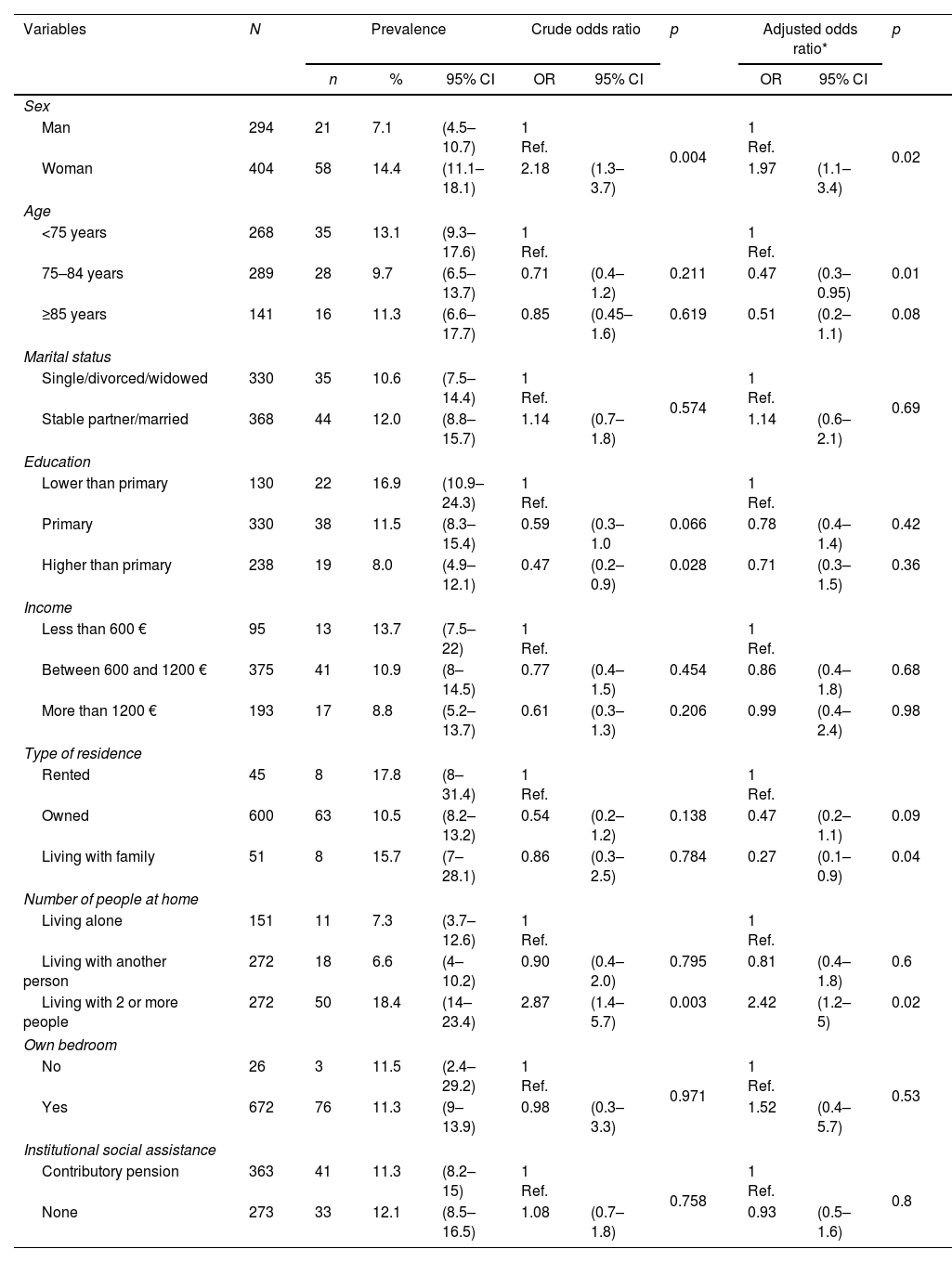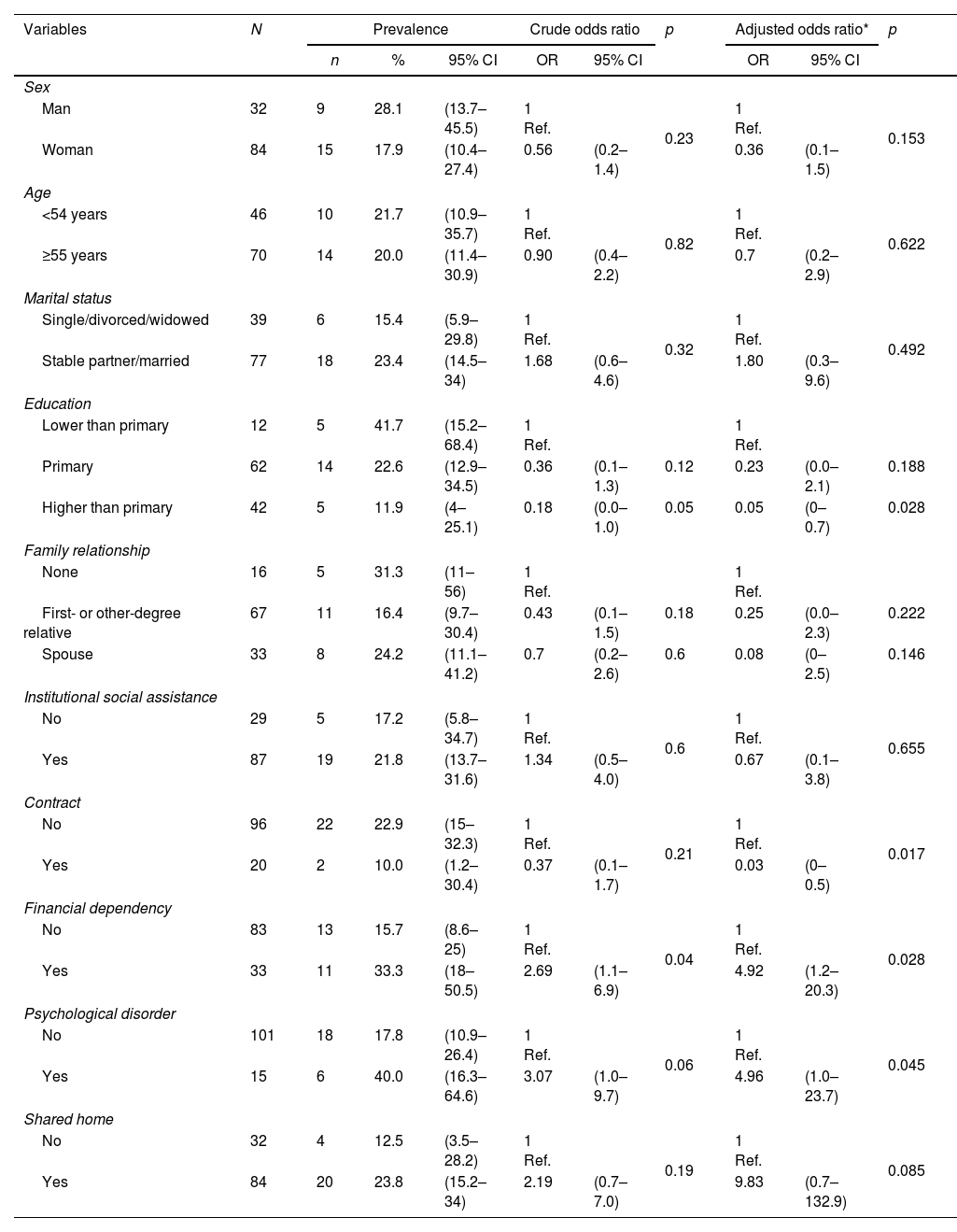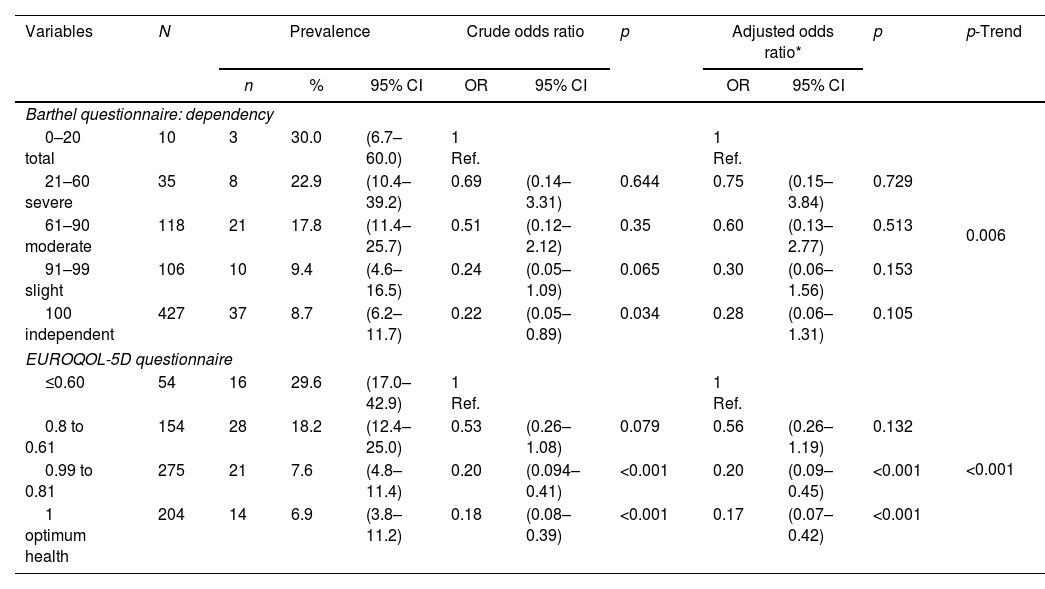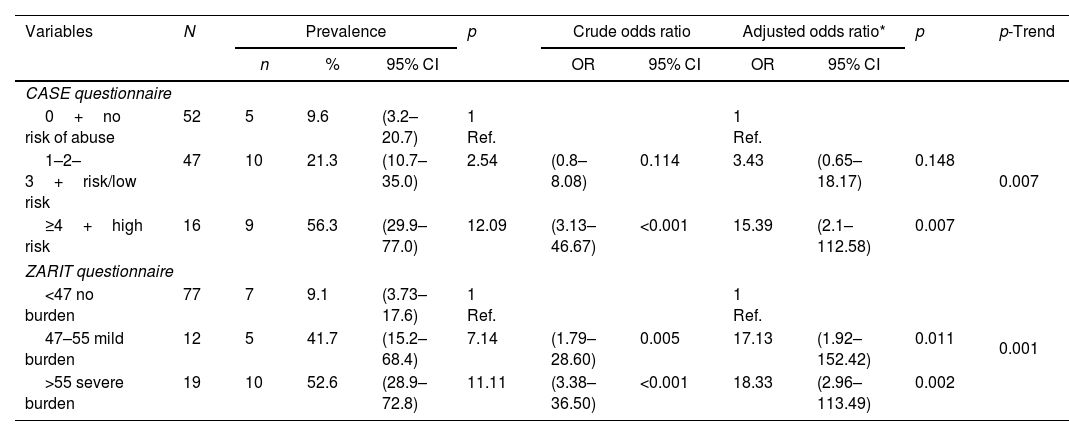To determine the prevalence of suspected abuse of non-institutionalised elderly people and the associated variables.
Patients and methodObservational, descriptive, cross-sectional, multicentre study in patients aged 65 years or older, non-institutionalised, consecutively selected in primary care (PC). The EASI questionnaires (Suspected Elderly Abuse Index), the EAI questionnaire (Suspected Abuse Index in patients with cognitive impairment), the Barthel index, and the EUROQOL-5D questionnaire were used with patients, and the CASE questionnaire and the Zarit test were used with caregivers. Socio-demographic, health, and quality of life variables were analysed in all patients.
ResultsEight hundred four patients were included, mean age 78.9±7.9 years, 58.3% women. The prevalence of suspected abuse was 11.3% (95% CI: 9.1%–13.9%). Suspected abuse was more frequent in women than in men (14.4% vs. 7.1%; odds ratio (OR)=1.97; 95% CI=1.1–3.4; p=0.016) and in those who lived with two or more people compared to those who lived alone (18.4% vs. 7.3%; OR=2.42; 95% CI=1.1–5.0; p=0.017).
Among older patients, the lower their dependency, the lower the prevalence of suspected abuse (30.0% in highly dependent vs. 8.7% in non-dependent: p-trend=0.006); and the better the perceived health status, the lower the prevalence of suspected abuse (29.6% in poor health status vs. 6.9% in optimal health status; p-trend=<0.001).
Among caregivers, the prevalence of suspected abuse was 20.4% (95% CI=12.8%–28.0%). A trend of higher prevalence of suspected abuse could be observed with higher scores on the CASE questionnaire (56.3% at high risk and 9.6% with no risk of abuse; p-trend=0.007). In the case of the ZARIT questionnaire with scores below 47, the prevalence of suspected abuse was 9.1%, and for scores above 55, it was 52.6% (p-trend<0.001).
ConclusionsThe results of the PRESENCIA study show that approximately 1 in 10 patients aged ≥65 meet the criteria for suspected abuse. The probability of abuse increases in women, in patients with greater dependency and in patients with poorer perceived health status. Caregivers with greater overload and greater risk presented a greater suspicion of elder abuse.
Conocer la prevalencia de sospecha de maltrato a personas mayores no institucionalizadas y las variables asociadas.
Pacientes y métodoEstudio observacional, descriptivo transversal multicéntrico, en pacientes de edad igual o mayor a 65 años, no institucionalizados, seleccionados consecutivamente en atención primaria (AP). Se utilizaron los cuestionarios Índice de sospecha maltrato (EASI), cuestionario índice de sospecha maltrato en pacientes con deterioro cognitivo (EAI), índice de Barthel, cuestionario EuroQol 5D, y en los cuidadores el cuestionario CASE y test de Zarit. Se analizaron variables sociodemográficas, sanitarias y calidad de vida en todos los pacientes.
ResultadosSe incluyeron 804 pacientes, edad media 78,9±7,9 años, 58,3% mujeres. La prevalencia de sospecha de maltrato fue del 11,3% (intervalo de confianza [IC] 95%: 9,1%-13,9%). Presentaban con mayor frecuencia sospecha de maltrato, las mujeres que los varones (14,4% vs. 7,1%; odds ratio (OR)=1,97; IC 95%=1,1-3,4; p=0,016) y aquellos que convivían con dos o más personas en comparación con los que vivían solos (18,4% vs. 7,3%; OR=2,42; IC 95%=1,1-5,0; p=0,017).
Entre los pacientes mayores se observó que a menor dependencia menor prevalencia de sospecha de maltrato (30,0% en muy dependientes vs. 8,7% en nada dependientes: p-trend=0,006); y a mejor estado de salud percibido menor prevalencia de sospecha de maltrato (29,6% en mal estado de salud a 6,9% en estado óptimo; p-trend=<0,001).
Entre los cuidadores, en los que se pudo valorar la prevalencia de sospecha de maltrato, esta fue del 20,4% (IC 95%=12,8%-28,0%). Se pudo observar una tendencia de mayor prevalencia de sospecha de maltrato a puntuaciones más elevadas en el cuestionario CASE (56,3% en riesgo alto y del 9,6% con no riesgo de maltrato; p-trend=0,007). En el caso del cuestionario ZARIT con puntuaciones inferiores a 47 la prevalencia de sospecha de maltrato fue del 9,1%, y para puntuaciones superiores a 55 fue del 52,6% (p-trend<0,001).
ConclusionesLos resultados del estudio PRESENCIA muestran que aproximadamente uno de cada 10 pacientes de la población ≥65 años analizada cumple criterios de sospecha de maltrato. La probabilidad de maltrato aumenta en mujeres, en pacientes con mayor dependencia y peor estado de salud percibida. Los cuidadores con mayor sobrecarga y mayor riesgo presentaban una mayor sospecha de maltrato al paciente mayor.
Artículo
Diríjase al área privada de socios de la web de la SEMERGEN, (https://www.semergen.es/index.php?seccion=biblioteca&subSeccion=revistaSEMERGEN ) y autentifíquese.
Comprando el artículo el PDF del mismo podrá ser descargado
Precio 19,34 €
Comprar ahora






